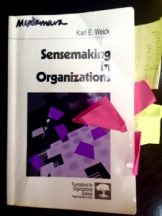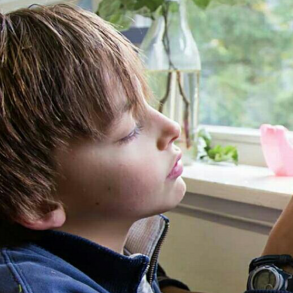Condensation by Zlatina Tsvetkova, based on this longer blog post by Laura A. McNamara
Have you thought about the way we make sense of life and the experiences we’ve had? Sometimes we would like to think it happens in projection to the future. We ask ourselves “What is the meaning of life?” and hope we can figure it out through speculation. Then, if and when we figure it out, we could fulfill it through our actions.
The truth is, it never works that way. We make sense of our experiences and the events of life retrospectively, through observation of events, plus reflection and negotiation about what these events mean to us.
Of course, the conversation around meaning of life is a heavy matter, so in this article I will focus just on making sense of events within organisations, based on this blog post by Laura A. McNamara. There she defines sensemaking as:
“Sensemaking describes the negotiation and creation of meaning, or understanding, or the construction of a coherent account of the world.”
She refers to it as “an elegant, subtle, and richly descriptive body of thinking about human perception, cognition, and action, as well as social interaction, institutional reproduction and change, and human agency.” All these concepts are associated with the process of making art and its role in society as a process that essentially helps us make sense of life and our experiences on an abstract and emotional level.
However, if we look broadly at the process itself, it “has tremendous implication for how we design and manage institutions, organizations, teams, programs, technologies.”
 A whole book has been written about those implications: Karl Weick, Sensemaking in Organizations. In it Weick also addresses the complexity of the term itself:
A whole book has been written about those implications: Karl Weick, Sensemaking in Organizations. In it Weick also addresses the complexity of the term itself:
You are being thrown into the middle of a sensemaking conversation with only a vague idea of how it constitutes a perspective.
In reality sensemaking is something that is part of the nature of our minds: they are hardwired to recognize and recall patterns, to act in response to them and even to create them. We naturally tend to “apply patterns from the material of our lived experience to impose order on that lived experience. Think of sensemaking as a ‘frame of mind about frames of mind’.”
“Weick tells us to learn about sensemaking by thinking about how we are learning about sensemaking. Read some of the text, he says. Set it aside. Consider it. Observe how you apprehend and integrate the ideas into what you already know. Articulate what you think you know about your learning. See that? That’s it. What you are observing and articulating is sensemaking in action.”
In his book, Weick identifies a set of seven properties that we can use “to understand how we create order from” the overflow of experiences and interactions we encounter every day. Words in italics are key terms that Weick uses.
- “Sensemaking is matter of identity: it is our understanding of ourselves and our relationship to the world around us.
- Sensemaking is retrospective: it is about the way we notice patterns that are meaningful to us based on our experience, and we can only notice patterns retrospectively.
- Sensemaking depends on our socialization: our upbringing, education, culture and the social norms that shaped us, as well as the people we are currently interacting with, have huge influence on our interpretation of the world.
- Sensemaking is ongoing: our environment, relationships, and our understandings of the world are fluid and continuously transforming. Laura McNamara describes sensemaking as “perpetually emergent meaning and awareness.”
- Sensemaking builds on extracted cues that we apprehend from sense and perception. Cognition is the meaningful internal embellishment of these cues. We articulate these embellishments through speaking and writing – the “what I say” part of Weick’s recipe. In doing so, we reify and reinforce cues and their meaning, and add to our repertoire of retrospective experience.
- Sensemaking is less a matter of accuracy and completeness than plausibility and sufficiency. Our limited cognitive and perceptual resources make it impossible to know or understand anything fully so the sensemaking process is limited to what works for us in a specific context in order to take action. If we attempt to know the facts and the reality exhaustively, we will get stuck in never ending analysis instead of progress.”
She says she has found “sensemaking theory to be a tremendously powerful guide for structuring my approach to qualitative data collection, particularly when I’m trying to figure out how an organizational initiative is (or isn’t) making the impact that its proponents have envisioned.”
By reflecting on each of the seven aspects of sensemaking, people who have gone through a certain experience or transformation are able to make sense of it and evaluate the impact it had on them. Such experience may be organisational change, experiment with new product, learning or reading something, or facing a challenge or conflict in your work.
In her blogpost, Laura A. McNamara gives the following example of how sensemaking changed her and her team’s perspective on a new social media project they were researching:
“As we analyzed our interview and observational data, we came to believe that Intellipedia and other forms of social media were disruptive not because they facilitated domain knowledge-sharing per se, but because Intellipedia was enabling its contributors make more effective sense of themselves and their expertise vis-à-vis the massive, complicated organizations in which they work.”
Thus a consciously detailed process of sensemaking helps us understand not only the impact certain experience has, but also what makes this experience have this particular impact. In turn, that empowers us to use our understanding to build more impactful experiences in the future.
Source: https://www.epicpeople.org/tag/sensemaking/. There are valuable comments on the original blogpost.
Quotations in italics are McNamara’s quotations from Weick. Quotations in quote marks are Tsvetkova’s quotations from McNamara.
Published with permission from Laura A. McNamara
 Zlatina is a writer, facilitator, and organisational choreographer using storytelling, meaningful conversations, system thinking, and the power of questions to help businesses bring more purpose in what they do, and more doing in their purpose. She hosts spaces for inspired intuitives, impact creators, and hardcore life thinkers to connect with the deeper purpose of what they do, with the joy of life, and with the authentic voice of their creations. She hosts mastermind communities of support, learning, and co-creation.
Zlatina is a writer, facilitator, and organisational choreographer using storytelling, meaningful conversations, system thinking, and the power of questions to help businesses bring more purpose in what they do, and more doing in their purpose. She hosts spaces for inspired intuitives, impact creators, and hardcore life thinkers to connect with the deeper purpose of what they do, with the joy of life, and with the authentic voice of their creations. She hosts mastermind communities of support, learning, and co-creation.
Featured Image/graphic link added by Enlivening Edge Magazine.





I like this reference to our constructive mind as the source of sense and meaning we then enshrine in what we call “the organisation”. For me the key to organizational development is in the processes of sense-making and meaning making, as they construct and maintain what we perceive as the organization. This triggered me to collect stories as artefacts of these sense-making processes, and to build a measurement of organizational culture through stories. How a story measurement can be set up and maintained over time I have described in this article https://enliveningedge.org/field-reports/shaping-company-cultures-self-organizing-recruitment-iec-report/.
It feels to me we are at the verge of re-inventing organizational culture as the ground from which organizations emerge, stay or evolve. And influencing the cultures within organizations is the work of leadership in self- as in traditionally managed organizations. Self-managed organizations have an advantage over the traditional ones here, as this culture basis is more apparent, and leadership present in all levels. A topic to be explored in more depth and with practice.